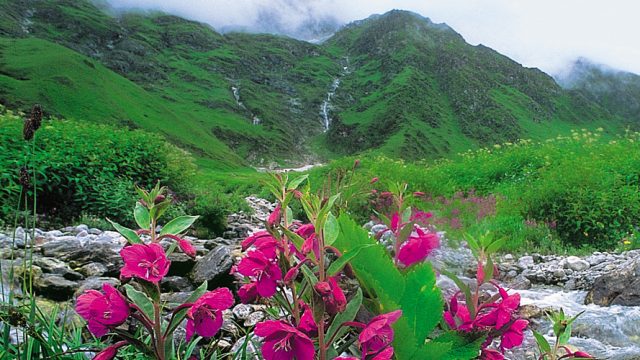In 1931, mountaineer Frank S Smythe and his colleagues, including the legendary mountaineer Eric Shipton, chanced upon a valley on their way from a successful expedition to climb Kamet, and were mesmerised –“It was impossible to take a step without crushing a flower…. The Bhyundar Valley was the most beautiful valley that any of us had seen. We… remembered it afterwards as the Valley of Flowers.” In 1937, Smythe returned to the valley to climb, explore and collect flowers and seeds. His reminiscences were published as The Valley of Flowers. The name stuck. Till 1982, the Bhyundar Valley was home to people who populated its hills, rivers and forests with stories about deities and fairies, and used its meadows as summer grazing grounds for animals. Then, it was declared a national park, out of bounds for locals who now had to run guesthouses and dhabas. Today it is a part of the larger Nanda Devi National Park and is also a Unesco World Heritage Site. The notified area of 87.5sq km lies above 10,500ft and is under snow from November to April. The valley contains a range of altitudes and vegetation; just 19sq km is the kind of fecund meadow land that tourists have access to.

Reaching the Valley
Something called by as intriguing and romantic a name as the Valley of Flowers shouldn’t be found conveniently off the highway! So, even after a long trip from Delhi to Joshimath, you have to hike up from a point called Govindghat. It’s a breathtakingly beautiful trek, with immense mountains, snowy backdrops, a gushing river and incredible greenery as you cross the Alaknanda, meet its tributary – the Bhyunder – and walk along it. After 5–6 hours, you reach the settlement of Ghangharia, which is the overnight halt for the valley.
Tip: The trek from Govindghat to Ghangharia (13km) is moderately tough. High altitude sickness is a possibility. Porters (₹500 per day) and mules (₹750 per day) can be hired at Govindghat and are also available en route
Next morning, wake up early because you may have to return any time around 2.00–3.00pm if it starts raining. You should take a guide because after an hour’s walking, you still may not find the meadow of flowers you are looking for. You have to tiptoe over a small glacier, reach the Bamini Dhar where the tree line ends and the valley becomes a bugyal (a high-altitude grassland meadow in Garhwal).

The Valley
The Valley of Flowers bursts upon you as an absolutely radiant canvas. Flowers plummet down from rocks, proliferate over every inch of space and devouring every morsel of soil. In May, large parts of the valley are full of blue primulas. In June, it is the purple-red of geraniums that dominate, but gives way to herds of lanky, fragrant polygonums in September. Monsoon time is when maximum flowers bloom. The valley is home to a bewildering variety of plants; in a few square kilo metres there are a hundred plant species to be seen. At the far end of the valley is where the Pushpawati spreads out into many streams.
Tip: Don’t expect big garden-variety flowers. Wildflowers are smaller, to be seen as part of a living ecosystem. Raincoats are a must. Guides at Ghangaria charge ₹500 for a day
Entry Indians ₹150; Foreigners ₹600
Permits: Valid for 3 days
Timings: 7.00am–3.00pm; Photography Free; Videography Indians ₹500 Foreigners ₹1500.

Where to Stay & Eat
Camping is not allowed in the Valley; the summer settlement of Ghangharia (or Govind Dham) is the base for excursions here. Camps are set up in season just before Ghangaria. Himalayan Eco Lodges (Dehradun Tel: 0135-2769696-97, Cell: 07895979208/ 211; Tariff: ₹5,000, with two meals) is the best option here. Other good ones include Ghangaria Camp Resort (Cell: 09412936360, 07579208060, 08449812304; Tariff: ₹6,500, with meals) and Camp Sarovar Ganga (Cell: 093593-33338, 094581 53317; Tariff: ₹4,500, with two meals). All offer luxury tents with attached bath. GMVN’s Tourist Rest House (Cell: 070602 11150; Tariff: ₹1,100– 1,980), Kuber Hotel (Cell: 0941240 7006, 09411767129; Tariff: ₹1,800–3,000) and Hotel Sri Nanda Lokpal Palace (Cell: 09412909307; Tariff: ₹2,850) are decent choices. The food available is vegetarian and plain. The restaurants also pack you food for carrying into the valley. There are dhabas on the way from Govindghat to Ghangharia. There are many trekking agencies which organise treks to the valley and to Hemkund. You could do the trek with Great Indian Outdoors (gio.in), which offers the trek at ₹9,900 per person. If you’re an experienced trekker, you can retrace Frank Smythe’s steps (in the opposite direction) by traversing the length of the Bhyundar Valley and crossing the 5,100m Bhyundar Khal (pass) at the head of the valley as well as the Rataban glaciers to the Dhauli Ganga Valley. GIO offers this trek for ₹27,500 per person.




